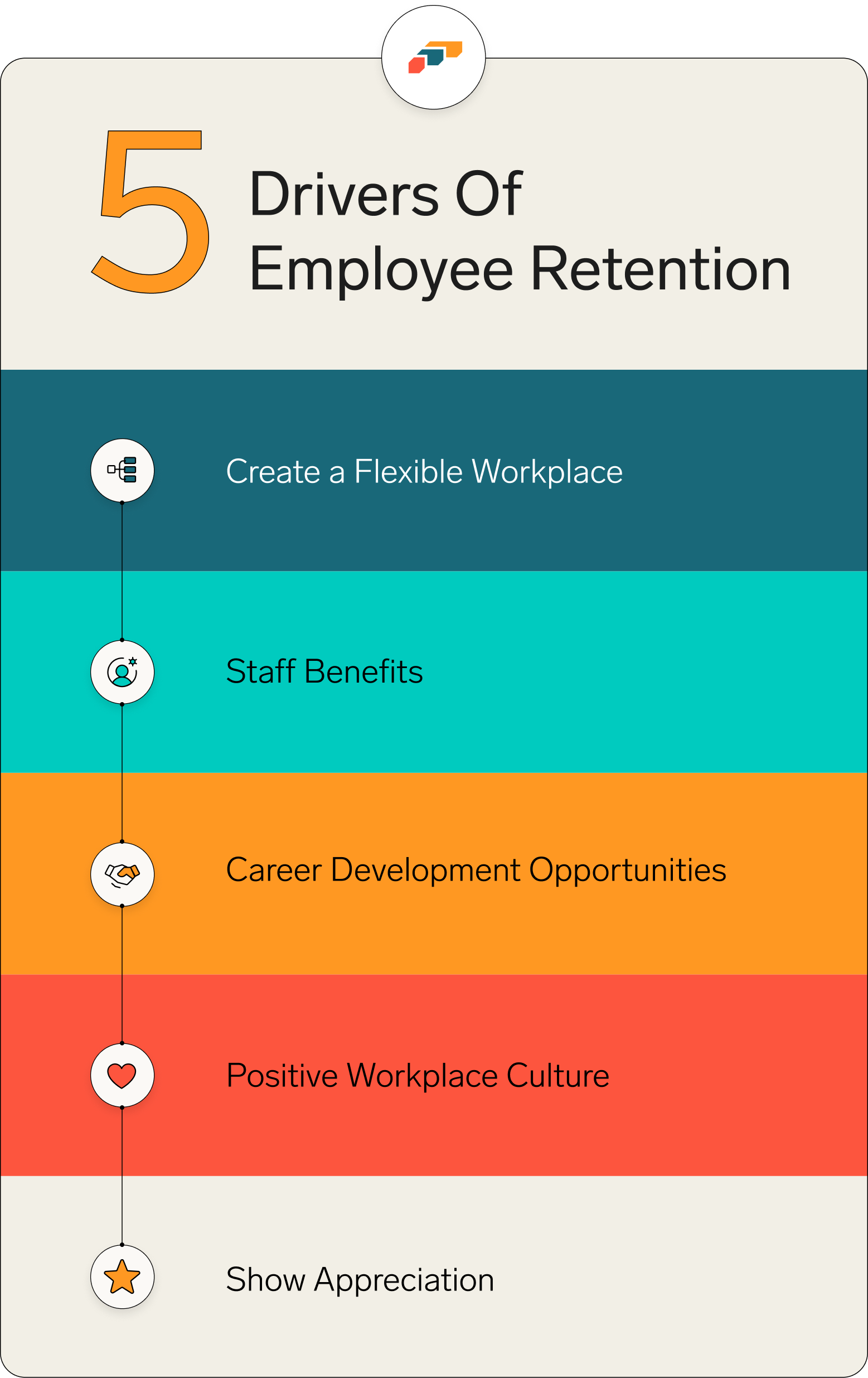90 Hiring Statistics: Challenges, Strategies, and Trends
Discover key strategies for successful hiring. Learn how to attract top talent and build a winning team effectively, based on current research and statistics.
- 30 Jan 2025
- Max 12 min read
The Number One HR Solution on Salesforce
Attracting and keeping the right people for your business is an exciting challenge that, when done properly, gives you the best chance of ensuring your existing and future team members are content and satisfied. With the after-effects of the Great Resignation, many employees are still rethinking their job choices, so it's essential for companies to have their talent acquisition and retention plans polished.
Retention means striving to minimize employee turnover so that your star employees stay with you for the long term. Retaining them comes down to creating a positive working environment that helps foster satisfaction and engagement.
To keep those superstars, it’s important to recognize their efforts, provide great perks, offer competitive salaries, and make sure everyone can live a healthy work-life balance. Don’t forget about optimizing the recruitment process too. Starting at the recruiting stage sets you up for success in keeping these talented individuals around.
Retaining great employees should be high on your priority list. High turnover rates are incredibly costly, not just financially, but also in time and productivity. Research from Gallup concluded that voluntary employee turnover costs American businesses a staggering trillion dollars every year. Moreover, the average recruitment process takes around 42 days before you find the right fit for the job.
If you want to maintain a successful business, it’s essential to create effective strategies for attracting and retaining the best talent. This involves new employees who have the right skills and experience and who are a good culture fit. Building a good company culture takes effort, care, and trust, all of which contribute to employee retention. Bad hires will have a negative impact on morale, so careful consideration needs to go into every hire.
Creating a culture of commitment and satisfaction among your current employees goes beyond the traditional ideas of employee satisfaction. Let's look at five of the most effective ways you can promote lasting retention.
One of the most important aspects of keeping an employee's morale high is allowing them a degree of workplace flexibility. This could mean allowing them to choose their own work hours, offering remote work opportunities, or flexible scheduling.
This type of freedom allows employees to structure their workload in a way that best suits them, giving them a sense of job satisfaction and making them more likely to stay in a role. According to a report by Forbes, 70% of respondents said that they would favor a workplace that has flexible conditions over one that offers higher pay premiums.
When companies are able to facilitate job satisfaction, it can lead to better employee retention and decreased turnover rates; something which is especially important for organizations with Millennials and Gen Zers in their workforce who prefer personalized roles.
Staff benefits are a key factor in employee satisfaction and retention. According to Access, around three-quarters of employees believe that they’re more likely to stay with an employer because of their benefits program.
Common staff benefits include annual leave, sick leave, retirement plans, childcare benefits, bonuses, healthcare benefits, wellness packages, and life insurance. Workplace perks can come in many forms, from discount programs and free healthy snacks to flexible hours or remote working options.
Providing workplace benefits helps your employees feel appreciated and rewarded and it also has a positive effect on company culture by improving employee wellbeing and morale. With the right benefits package, you can create an unbeatable employee value proposition that stands out from your competitors.
Nurturing career development is an important part of retaining talented employees. If employees feel like their roles lack opportunities for growth, they may become discouraged and seek employment elsewhere. To show your commitment to their professional development, you can offer extra training courses or sponsor educational courses.
Mentorship schemes and skills-based workshops are also terrific tools to create a healthy company culture and foster employee satisfaction. Take an active interest in employee career goals and be supportive; it’s the little gestures that make all the difference. Encouraging staff to map out their career paths and learn new skills will increase engagement and loyalty, making them more likely to stay with your organization in the long run.
A positive workplace culture can truly make a world of difference, leading to increased productivity, greater staff engagement, and improved employee retention. For example, when morale is low that is when people begin to look for new opportunities elsewhere.
So what exactly makes up a positive work environment?
Workplace culture encompasses many aspects, such as work practices, attitudes, goals, behaviors, and company values. Business leaders should take the following into account when cultivating an uplifting corporate culture:
There's no denying that employee recognition and retention are strongly connected. According to a study by Bonusly, 82% of employees surveyed consider recognition an important part of their happiness at work. Some 63% of those who felt recognized at work were more committed and less likely to look for a new job.
If employers don't take the time to give their staff the appreciation they deserve, how can we expect them to stay motivated, productive, or content in their roles? For this reason, businesses should make sure their staff are getting the recognition they need – whether it's through a formal program or software solution. Such initiatives can increase retention rates while keeping existing workers satisfied. The most successful organizations institute all five points into their processes to ensure a healthy working environment.

The pandemic brought unprecedented challenges for employers and employees alike, and in the Great Resignation of 2021, many employees began looking for a more fulfilling work experience. Human resources departments are still feeling the consequences and must continue to re-evaluate and strengthen the relationship between companies and their staff. Keeping your team happy and motivated plays a major role in ensuring the success of any business.
A survey conducted by FlexJobs in 2022 found that the number one reason people leave their job for greener pastures was a toxic company culture (62%). This was closely followed by low salary (59%), poor management (56%), and a lack of healthy work-life balance (49%)
Other reasons people choose to switch companies included:
On the otherhand, a the Unwrapped 2023 Workforce Study by Snappy revealed the top reasons why American employees want to remain at their current company:
It also shared that showing appreciation is vital in retaining and engaging talent, with 90.3% of Americans beleiving that a company should recognize employee contributions with regular tokens of appreciaition, and 66.7% reporting that they would be more likely to stay at their current company if they were to receive an annual gift from their employer.
Certainly, all this isn't easy to achieve or maintain, but at the end of the day, the rewards associated with an excellent employee retention rate far outweigh the effort put into making sure your organization succeeds in this regard. Make sure you focus on providing incentives across all key areas to lower your employee turnover rate and boost overall satisfaction.
Anytime is the perfect time to introduce employee retention strategies and foster leadership development. Investing in retention initiatives can help you avoid costly adjustments due to turnover and create a positive work environment for employees.
These days, job seekers are no longer just searching for salary and benefits but also the company values that align with theirs. When the employment rate is low, job candidates have more power to shop around for better opportunities that suit their values.
If you're observing an unusually high turnover rate, it's essential to prioritize investing additional time and effort into employee retention. A valuable approach to understanding the reasons behind their departure and enhancing staff retention strategies is by actively seeking feedback from departing employees.

Employee retention isn't just about implementing the right strategies, it's also about nurturing these initiatives on a long-term basis. If you're looking for ways to maintain your success in employee retention, here are a few ideas that you can put into action:
The key to boosting employee satisfaction is to focus on long-term benefits. When it comes to staff retention, conditions can be improved over time.
Perhaps you want employee wellness to be part of your retention plan. If so, you'll need more than just a single well-being workshop. You'll need to provide ongoing wellness programs, to consistently support your staff.
Once your employee retention strategies are in place, make sure to evaluate their success periodically. Aim to assess the effectiveness of your strategies and continue making progress where appropriate.
Analytics can help businesses to examine their successes and weaknesses, and strengthen their employee experience. Many respected companies rely on analytics for performance and retention, such as Sysco, Best Buy, and Google.
To keep up with employee satisfaction, it's helpful to ask your team for regular feedback. Ask current employees what they like and dislike about working for the company.
HR teams can use various types of surveys to gain valuable employee insights, including:
By utilizing these different survey types, you can gain insightful information from employees which helps to assess satisfaction levels, detect areas needing attention and make informed decisions to optimize the employee experience.
Having a positive company culture is the key to building loyalty with your staff. Creating a welcoming work environment for your employees is essential for reducing staff turnover. Establish positive practices that continually strive to make your company better and stronger.
Additionally, focus on creating an inclusive and diverse workforce. Not only is it the socially responsible thing to do but it can make or break whether a candidate chooses you over another employer. In fact, research by Glassdoor showed that 76% of job seekers and employees say that a diverse workforce is an important factor when weighing different companies and job offers. Transparency is an important part of establishing a positive company culture, and transparency should be present in every aspect of your operation. For example, if you teach your employees rights when they’re returning to work after an injury, they'll feel more comfortable coming to you during a Worker's Compensation dispute. This ensures that your employees stay healthy and safe while working in your company.
Retaining your best employees is an ongoing effort. Review the data to learn more about why turnover rates may be higher than normal, and use these findings to continue crafting the best workplace possible.
Remember that your retention strategy is only as good as your hiring process. Attracting and keeping the right people is essential for any organization. That's why it's essential for HR professionals to think strategically and be proactive when recruiting. Start by expressing clearly the organization's values, culture, and long-term vision in job descriptions; this will help potential candidates understand if their aspirations align with the company's goals before they make a commitment.
Furthermore, ensure that hiring managers assess not just technical but also the soft skills needed for success in a role, such as communication, problem-solving, and teamwork. Additionally, interviews that focus on behavior and situations can identify candidates with a strong track record of loyalty and dedication to their previous roles.
Investing in an effective International HR strategy and comprehensive onboarding processes helps new hires settle into the company culture while creating an environment that encourages employees to stay with the organization long-term. And keep the communication channels open so your team knows what opportunities for growth and professional development are available. By taking these steps during recruitment, your organization will attract and retain individuals who share its long-term goals, creating a stable and dedicated workforce.

Employee retention is a must if you want to avoid expensive turnover and productivity lapses. Unless you pay attention to staff retention, your company can suffer from high turnover rates, which could disrupt your company's culture and morale. flair’s all-in-one HR solution provides all the tools you need to upgrade the employee experience, recruit and retain top talent. From hiring and onboarding to training, feedback, and employee recognition, flair automates and simplifies your tasks so you can focus on what matters most- the people in your team!
flair can also support your team’s implementation of retention strategies such as workplace benefits, wellness programs, flexible conditions, and career development opportunities. Keeping your top talent is about leveraging analytics and helping your workers find purpose.
To maintain employee retention, it's essential that you keep making improvements and use data from your exit interviews and employee feedback. A positive company culture is the key to success and growth, and enhancing the employee experience will encourage retention and guarantee that you have a dedicated, happy, and healthy team.
Join flair’s newsletter to receive the latest tips & trends in the HR world.

